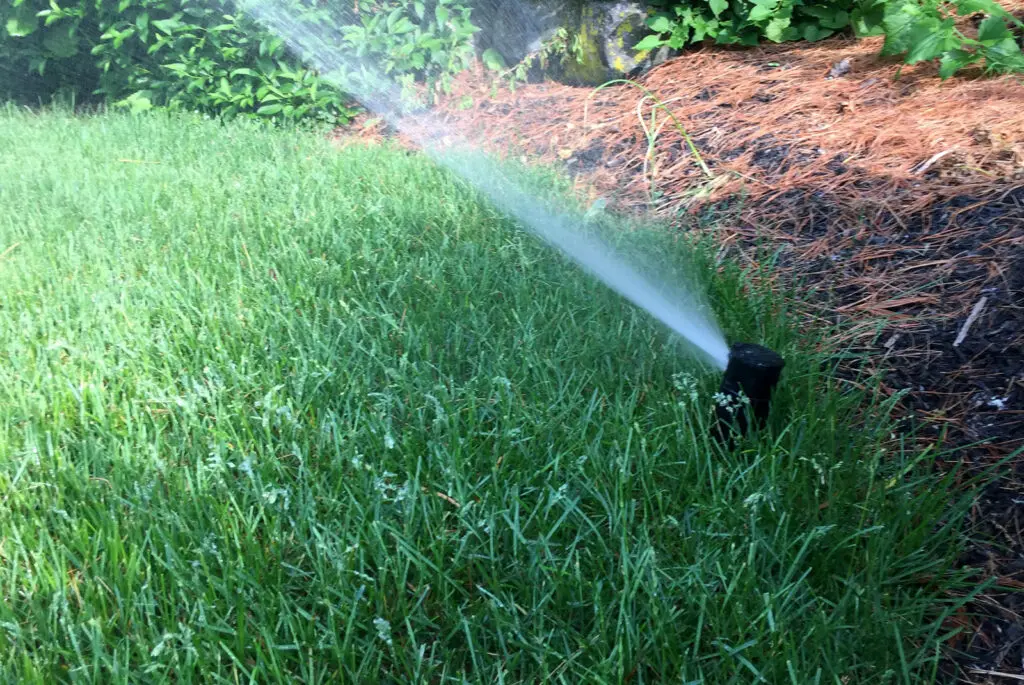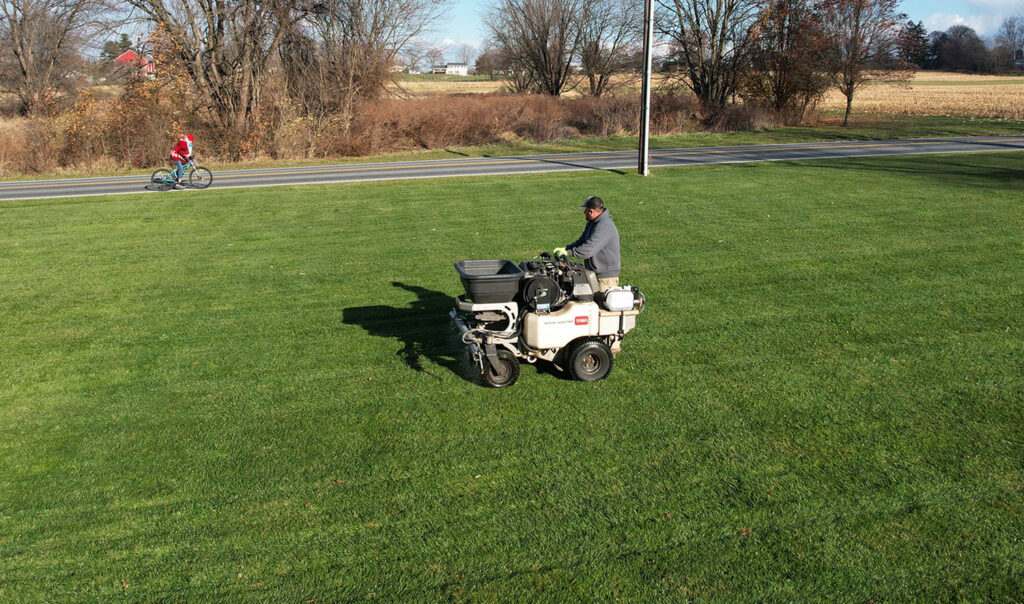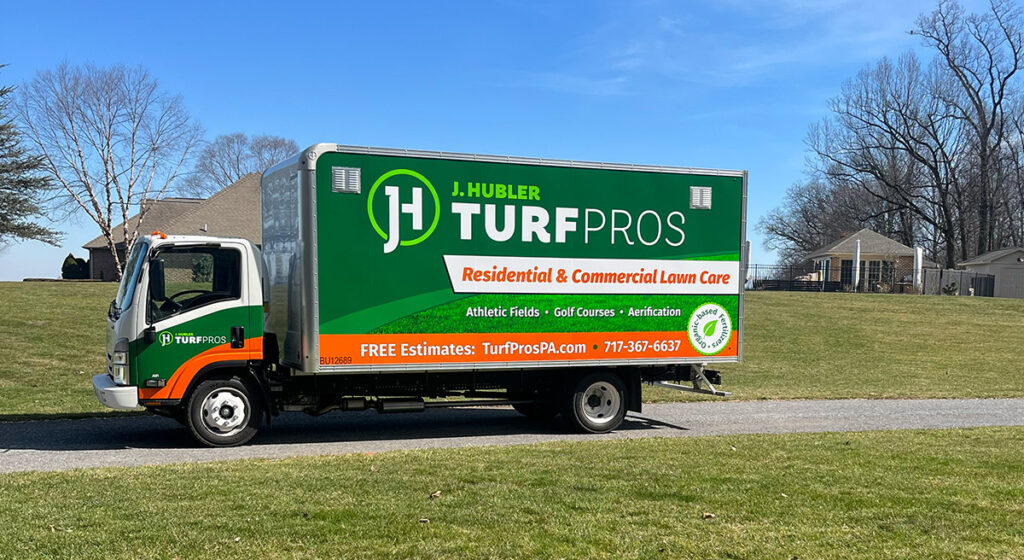
Stop Wasting Money on Your Lawn—Here’s How to Get It Right
Many homeowners, business property managers, and athletic field directors waste money on lawn care without seeing the results they want. You spend hours online searching for solutions, spend hundreds on what you think you need, and take your best guess at when and how to apply the products, just to still be left with bare spots and unsightly weeds. Frustrating, isn’t it? The good news? With the right strategy and support, you can grow a thick, green lawn while saving money, time, and effort. Here’s how to avoid five common money-wasting mistakes—and what to do instead.

1. Wasting Money on the Wrong Grass Seed
The Mistake: Buying whatever grass seed is on sale without considering your climate and soil.
You look out across your lawn and realize it’s losing its luster. There are bare spots and the grass that is there just isn’t as vibrant green as it once was. So you decide to check your local outdoor store to find whatever seed is cheapest and toss it out across your lawn with the best of intentions. However, weeks go by and you have nothing to show for your money. But what went wrong? Was it the type of seed that you bought? The timing of your application? Maybe it was a combination of many variables that didn’t allow your grass seed to take root.
The Smart Move: Choose the right grass seeding strategy for your lawn.
Not all grass seed is the same! In Central PA, hardy, cool season grasses like Kentucky bluegrass and fescue blends do best. Cheap seed may not grow well, leaving you with a patchy lawn and wasted money. Instead, try overseeding in the fall to fill in bare spots and prevent weeds. Keeping your grass at the right mowing height will also help it stay healthy and strong.

2. Overwatering or Underwatering Your Lawn
The Mistake: Running your sprinkler system too often—or not enough.
Most people think that an irrigation system is something you can set and forget, but without regular check-ins, this can cost you big time! When it comes to regular lawn grass maintenance, the right amount of water is key. Things like low spots in the lawn, holes around sprinkler heads, and leaky irrigation lines can result in costly damages to your lawn. Whether it’s residential, commercial, or an athletic field, irrigation is a key part to keep your lawn healthy and strong.
The Smart Move: Water the right amount for deep root growth.
Too much water drowns grass roots and encourages lawn problems like disease. Too little water leads to shallow roots and dry, weak grass. The sweet spot? One to two inches of water per week, ideally in deep, infrequent sessions. If you’re unsure, put an empty tuna can on your lawn—when it fills up, you’ve watered enough!
Schedule regular irrigation checks to check for broken sprinkler heads to ensure there isn’t pooling water or muddy spots that can lead to pest issues like mosquitoes.

3. Waiting too long to hire a professional
The Mistake: Wasting money on lawn care products that don’t work and letting them stack up in your garage.
Many people assume professional lawn care services are out of their budget, so they spend unnecessary money on products that don’t quite work and end up with larger (and more costly) issues. Considering the cost of quality products and the expertise needed for effective application, hiring an expert can actually save money in the long run. When going the DIY route, it’s important to consider the time it takes you to gather the knowledge necessary to know what you need, what to purchase, and how to apply it; all on top of the expense of buying and storing these expensive chemicals. And, taking the time to apply them.
The Smart Move: Partner with a professional lawn care treatment company to apply professional-grade fertilizer, weed control and pest control solutions.
Do you know the differences in treating broadleaf weeds versus grassy weeds? Instead of spending hundreds on products that may not even work and will inevitably have to be stored somewhere, hiring a professional is more cost effective than you may think. JHL Turf Pros’ services start at $79.95 per treatment making it less than $400 a year! Services like these also come with a WEED-FREE Guarantee ensuring your lawn stays healthy all year long without your budget taking a hit.

4. Fertilizing at the Wrong Time (or Not at All!)
The Mistake: Skipping fertilization or applying fertilizer at the wrong time of year.
It may feel like you are saving money by skipping out on the fertilizers, pre-emergents, and other preventive lawn and grass maintenance methods. However, waiting until the problem becomes visible is waiting far too long. Treating weeds, rebalancing soil, and other lawn problems can be much more costly than what it would have cost to take those preventive measures.
The Smart Move: Fertilize your lawn strategically to improve soil health.
If you don’t fertilize your lawn, you’re missing out on the easiest way to get thicker, greener grass and have stronger root growth. The key? Apply a slow-release fertilizer in early spring and early fall. Healthy soils lead to strong root growth and better drought resistance. Bonus Tip: Aerate your lawn before fertilizing to help nutrients reach the roots more effectively. And to go that extra mile and give your soil exactly what it needs, go for a soil test before applying product of any kind.

5. Cutting Grass Too Short
The Mistake: Mowing too low in an attempt to mow less often.
We understand, you’re busy and mowing your lawn is the last way you want to spend your precious time. However, mowing below proper heights for your grass type can cause extensive damage – like drying out your lawn, exposing the soil to more weeds and pests – that can cost you in repairs.
The Smart Move: Adjust mowing heights to the ideal level.
Scalping your lawn (cutting it too short) weakens the grass, leading to thinner lawns and more weeds. Instead, mow at the correct height:
- Kentucky bluegrass & fescue: Keep it at 3–4 inches
- Warm-season grasses: 2–3 inches
This helps shade out weeds and promotes deeper root systems, making your lawn healthier over time and more resistant to weeds and disease.

BONUS: Smart budgeting for lawn grass maintenance
If you’re serious about maintaining your lawn while saving money, here are a few final tips:
- Invest in lawn insect control services to prevent costly pest damage.
- Keep up with time management—small, consistent lawn care efforts save money long-term.
- Skip unnecessary treatments—test your soil health before buying extra lawn products and don’t put junk food on your lawn.
By avoiding these five costly mistakes and switching to smart, expert approved lawn care strategies, you’ll get the lush, green lawn you want—without wasting money.
For more lawn care tips on how to keep your lawn healthy, all year long checkout this guide: 6 Essential Lawn Care Tips for Central PA Residential & Commercial Properties
